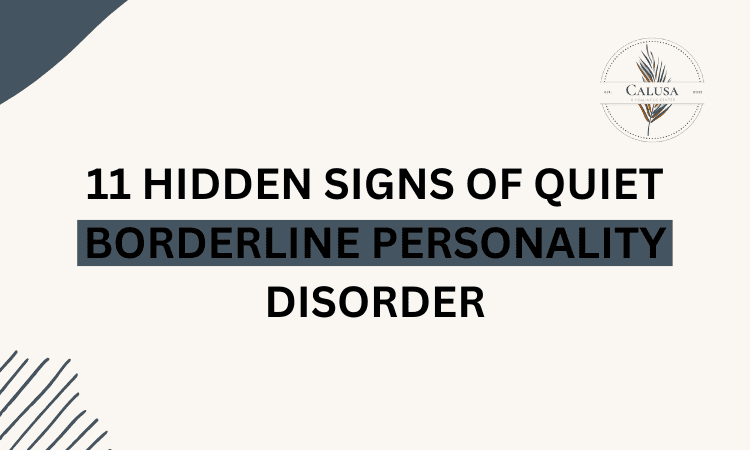Quiet Borderline Personality Disorder (BPD) is another type of this disorder that is not readily apparent and for which symptoms can be difficult to identify. Patients suffering from this illness might suppress their pain and hurt and therefore it becomes difficult to see their problems. Recognizing 11 such hidden symptoms of borderline personality disorder called quiet can go a long way in shaping the management of the disorder and thus the help offered. In this article, we will discuss these warning signs in detail so that you know what questions to ask.
Does your quiet pain feel unbearable?
What is Quiet Borderline Personality Disorder?
It is a subtype of BPD where the patients suffer in silence. They are outwardly calm yet in the throes of emotional distress, which is usually not apparent with other kinds of BPD. There are more obvious signs of BPD like rage and lifelessness that are not so common in quiet BPD. There is recognition of 11 hidden signs of quiet borderline personality disorder that can aid in the effective management and treatment of this problem.
11 Hidden Signs of Quiet Borderline Personality Disorder
The presence of the 11 hidden signs of quiet borderline personality disorder is not so easily alluded to as these symptoms are most of the time subtle. Listed below are some of the acute signs of this illness that have been expanded upon:
Emotional Numbness
If a person suffers from quiet BPD, their emotions may seem so blank, or so far away that they cannot be engaged. This is why one can find it hard to gauge their real emotions.
- Their discomfort may not be appreciably visible.
- Interactions may seem trivial, or lacking substance.
Chronic Self-Doubt
Self-doubt is an epidemic that is suffered by a large majority of the population where the individual metalizes himself and all of his decisions. Such internal strife can lead to disturbing levels of stress and issues regarding self-worth and respect.
- They might often question themselves regarding the decisions that they have made.
- They might try to get more validation from people even without asking.
Avoidance of Conflict
With quiet Borderline Personality Disorder, one would most likely choose not to engage in arguments or conflicts rather than face them. Unfortunately, this leads to more problems than solving them in the future, as aim cases remain unaddressed and accumulating tensions.
- They might be very reluctant to talk about the issues.
- There are likely to be missed or down-played dangerous interactions.
Internalized Anger
Emotions, and in this case, anger often come but unlike in most cases, it comes out in the other direction. This is frustration directed at oneself and which may not be visible to others.
- There may be times when they will be self-critical.
- Anger can be afflicted and hidden.
Fear of Abandonment
People with abandonment issues will sometimes act out. They might do this because there’s a well-embedded fear within them, but one that would hardly be verbalized. What results from this is a tremendous level of hysterical deprivation and dependence where relationships are concerned.
- They might be an overreliance on other people.
- Exaggerated fears of separation will cause them to become clingy in relationships.
Subtle Self-Harm
It is easy to hide or downplay self-harming actions. It could also mean behaviors or thoughts that produce harm but should not be limited to.
- There are some hidden ways how they may get hurt.
- Self-injury may also be of an obscure type.
Over-Sensitivity to Criticism
Every single criticism, however minor, feels like the end of the world. It is our understanding that while individuals suffering from a silent form of borderline personality disorder may be hotheaded about feedback, this hotheadedness is oftentimes concealed.
- They might internalize criticism excessively.
- Reactions to criticism can be disproportionate and hidden.
Dramatic Change of Moods
Mood shifts can appear in short periods of time but are usually not detected by others. These changes can cause a lot of trouble for these people’s surroundings.
- Mood swings may be sudden and intense.
- These changes can be difficult for others to predict.
Relationship Management Challenges
Owing to personal inner conflicts, people might fail to secure a relationship with a secondary person. The nature of such problems, especially superficial ones, may lead to complicated interactions with other people.
- Relationships may propensity towards a whirlpool ridden by the storm.
- There may be cases of failure in collaborative understanding.
Chronic Feelings of Emptiness
Chronic feelings of emptiness and negative imagery of loss can be so profound that words can hardly do justice. This emptiness is an experience that is often inward.
- Some of them would say that they feel that they are empty inside.
- The emptiness can remain in the unshakable bottom.
Avoidance of Self-Reflection
Individuals with quiet BPD may steer clear of issues of self-reflection which makes it hard for them to seek or show feelings.
- They may find it easier to forget about their own feelings.
- There might be hesitation with sharing inner feelings
It can prove difficult to locate the 11 hidden signs of quiet borderline personality disorder, but that information is relevant in order to assist. When identifying those who have quiet borderline personality disorder it is necessary to pay attention to the unnoticed signs as they may aid in the encouragement of health seeking.
Your Journey to a Brighter Tomorrow
Conclusion
Being able to locate the 11 hidden signs of quiet borderline personality disorder is ridden with challenges due to the gentleness of these symptoms. Support for individuals experiencing quiet BPD is when the symptoms are noticed and appropriately addressed. Over time, it might become apparent that some of these emotional numbness, chronic self-doubts, and other internal issues like BPD are not a depressive status that only needs to be relieved but a more start-B support-oriented intervention.
It is critical to note that if you or somebody you know is experiencing these hidden signs, you should seek help. That is the most important starting point. If you believe that you might be suffering from any of these hidden signs, the first step is to seek help from a specialist, and at Calusa, we are prepared to assist patients in such ordeals.
In social situations, do not sit passively waiting for further signs that will be more evident. Calusa is at your service. Come on in and let us understand and help you cope with the quiet borderline personality disorder. In this case, together let us bring about a positive change in such people. There is empathy and action; they can be a lifeline toward an equitable and brighter existence for those who need it.
FAQs
Q: How do you know when someone is a quiet borderline?
A: Identifying a quiet borderline is another complicated situation because their issues seem to be more of an internal battle. Indicators of emotional numbing, low self–esteem, conflict avoidance, anger turned inward, and fear of abandonment are some of the red symbols. Such may not be clearly articulated, but their effects are just as debilitating.
Q: What employment options do people with borderline personality disorder have?
A: Employment opportunities that provide a certain degree of order tend to be useful to patients with borderline personality disorder (BPD). Opportunities in the arts, caring or counseling professions, and occupations with discrete activities or flexible working patterns are probably appealing.
Q: What is the longevity of individuals diagnosed with borderline personality disorder?
A: The average lifespan of a patient suffering from borderline personality disorder (BPD) is generally comparable to that of the general population. However, even if the mental burst is not the core issue, BPD is likely to be associated with various challenges that can compromise the quality of life, thus the importance of early illness management and support for maintaining a good quality of life.
Q: What are the unspoken signs of BPD?
A: Unspoken signs of borderline personality disorder (BPD) include emotional numbness, chronic self-doubt, avoidance of conflict, internalized anger, and a deep fear of abandonment. These signs can be subtle and not immediately apparent but are important for understanding the condition.










